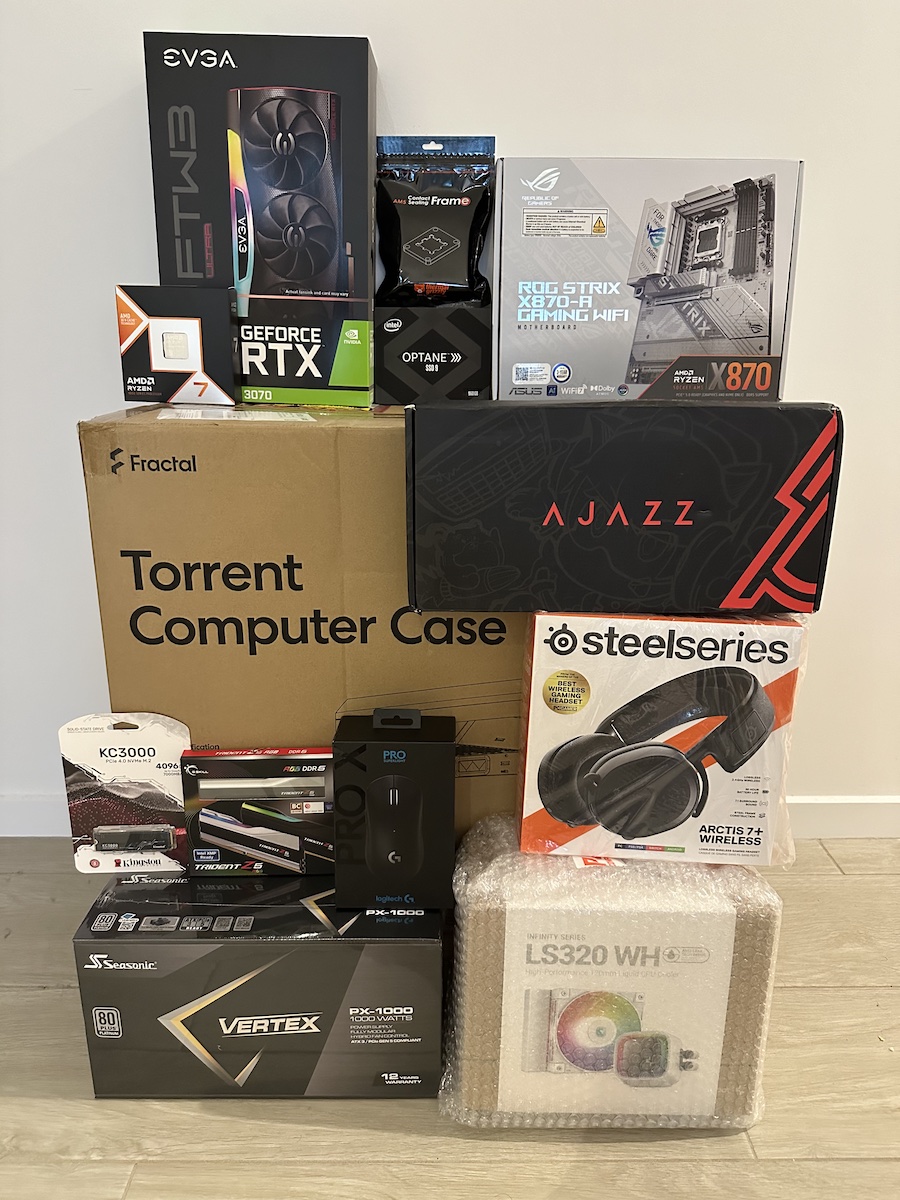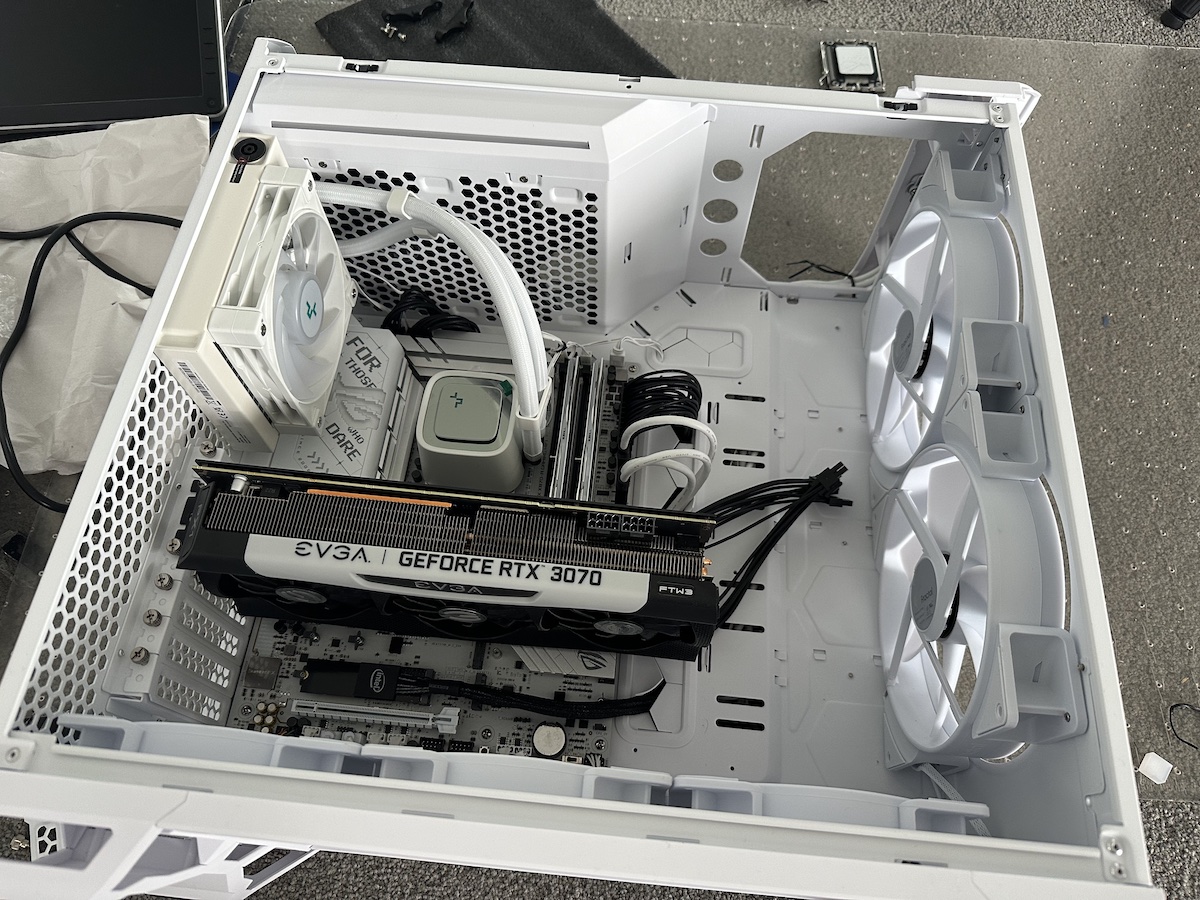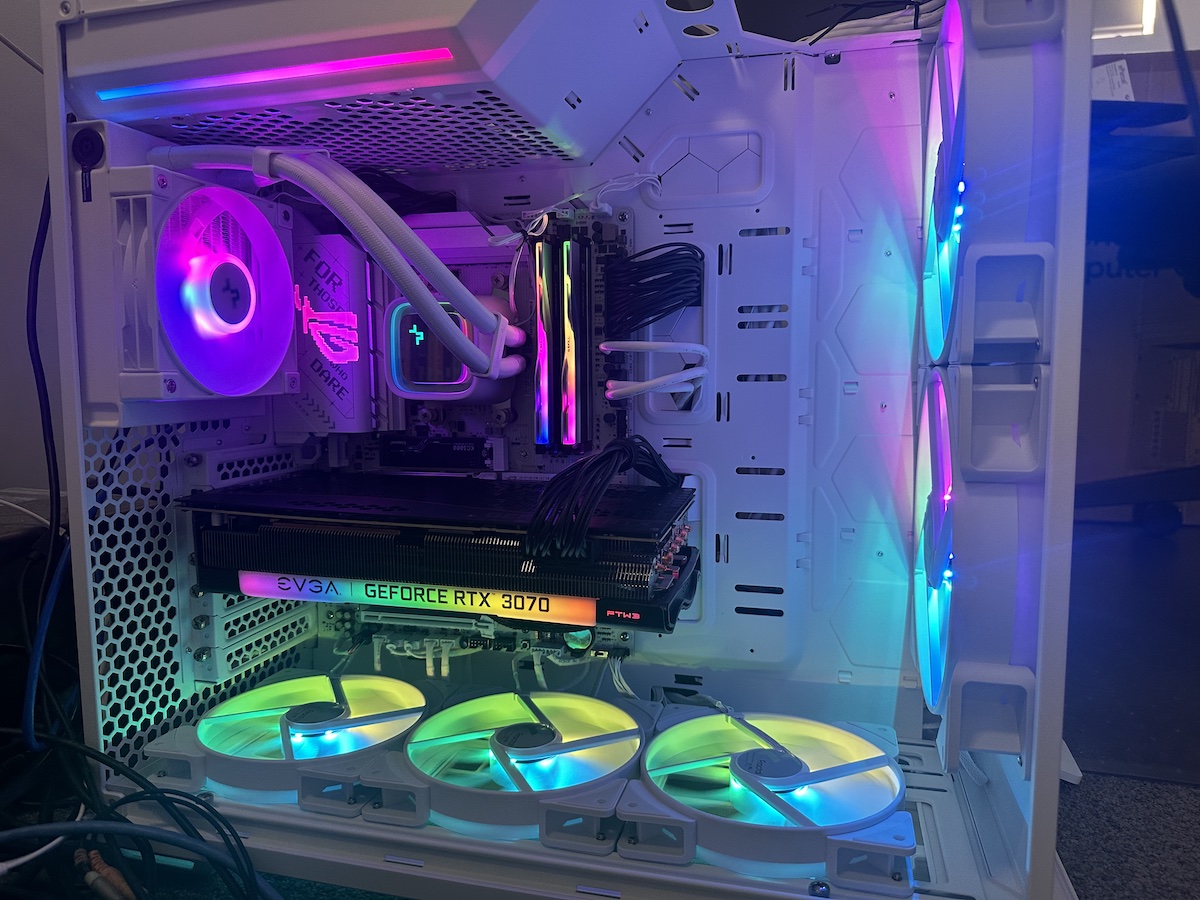New PC: Crinus Muto

I have now painstakingly assembled all the parts to build an almost entirely new computer, reusing only the graphics card from my current PC. Over an extra long weekend, a handful of weekends ago, I just as painstakingly attempted to assemble them into some semblance of a computer, repeating events that occurred nine years ago.
Which is to say, it’s been a while since I’ve built a new PC.
Just like last time, I’ve been thinking about putting together a new PC for a while now. I haven’t, mostly, because while my PC may be getting a little long in the tooth, it still plays the games I want to play. I’ve upgraded it a little since then — a new graphics card, and a new NVME SSD to add to the pre-existing NVME boot drive, but apart from a few peripheral changes — which I don’t really count as upgrades per se, as they’re, you know, peripherals, that’s it! It’s as stock as the day I put it together, all those years ago.
Because as much as I wanted to upgrade my PC, there were things that just took precedent. Other, adult stuff. But bit by bit, piece by piece, I knew what parts I wanted, even if I wasn’t sure what the overall platform would be, or even when I would be building it.
While that all seems like it adds up to a pretty big number, it’s all been spread across a few years. It’s honestly a pretty mediocre time to build a new computer. It might be an OK time to build a new PC if you’re planning to reuse your graphics card, as was the situation that I found myself in, but if you want to buy a new graphics card, then it’s a terrible time to build a new PC. Your graphics card will be the most expensive component by far and might even be the entire cost of the rest of your PC depending on which model you’re buying, if you can even find one in stock to buy in the first place. Like I said, terrible time to be building a new PC if you need to buy a new graphics card right now. Might be better in the coming months, but that remains to be seen.
As for me, I’m reusing two parts from my current PC. A 4TB NVME SSD, and my beloved RTX 3070 graphics card, which technically makes it the first part I purchased for the new computer, even if I didn’t know it at the time. I bought a 3070 in 2021, right in the middle of Covid and paid an embarrassing amount for it, as was the custom at the time. While I kinda wish I waited for 3080s to be in stock, I had a good reason for upgrading at the time, because my just-as-old GTX 980 was showing worrying signs of instability and was likely on its last legs.
And if we’re not counting peripherals, I bought an Intel Optane SSD back when you still could in 2023, with the intention of using it solely as my boot and temporary ShadowPlay drive. While I don’t think I’ve had an SSD die on me due to exhausting its write capacity, I know it’ll be hard to kill an Optane drive with writes, even if I’m trying to. For context, my current nine-year old boot drive, a 512GB Samsung 950 Pro, has had about 50 TB written to it in that time.
I picked up a DeepCool 120mm AIO mid last year for about a third of the price of what a Noctua NH-D15 G2 would have set me back, and as the 120mm variant was also quickly becoming unobtainable, I could have it in any colour, as long as it was white. Which pretty much sealed the deal on whether I’d be doing an all/mostly-white build, because next was the case. I’ve wanted a Fractal Torrent ever since I saw reviews of it a few years ago, and I ended up grabbing the white RGB version in the middle of last year, around the same time as the cooler. At the time I wasn’t sure if I wanted to do an all-white build, but I figured I at least wanted a white case and white cooler, even if the rest of the system was black. I think the contrast would have been nice.
And over the past six to eight months, the system has come together all by itself, bit by bit, piece by piece. Another SSD was next, then some RAM, and evidently the marketing is working (or I’ve been watching too much LTT), because I had my heart set on a Seasonic PSU and wouldn’t settle for any other, even if there were technically better options available with the requirements that I had (80 Plus Platinum or better, ATX 3.0 or better, Cybernetics A or better, etc). While I consulted the PSU tier list, the models at the top of the list either weren’t available in Australia, or commanded a higher-than-expected premium over competitors, with the rest of their A-tier PSUs being more or less the same. So, the marketing worked, and I now own a Seasonic power supply. PSU tier list be damned. While the original plan was for more RGB, I’m still on the fence whether I want to do that, and/or some custom length sleeved cables. As nice as it might be, as much of a little pizzazz that it would add, it seems like a bit of a pain to have to undo all my hard work when I spent two hours cable managing the thing. We’ll see.
With the rest of the system now put together, all I had to do was decide on the platform. If the graphics card is the most important component of any higher-tier gaming PC, then the CPU and motherboard are undoubtedly number two and three.

But first, I had to decide: Intel, or AMD? As someone who has always built Intel machines, it would have been quite a change to go with AMD. I do think CPU brand choice currently matters less than GPU brand choice; yes both Intel and AMD CPUs do more or less the same thing with minor differences (Intel has Thunderbolt, AMD does PCIe bifurcation, neither of which might matter for you if you’re building a mostly gaming-oriented PC†), but Nvidia GPUs currently do raytracing way better than AMD ones, but other things like driver stability are much of a muchness. Historically, the Intel or AMD conversation for price/performance has also been much of a muchness, with each side trading blows and enjoying their own periods of time at the top, but right now, for the gaming-centric focus of my PC, AMD’s X3D chips with 3D V-Cache top the charts and Intel languishes in the middle of the pack.
After thinking about it for a few weeks, there was only processor that made sense, even if my heart wanted another. But this time around, the brain won, and I’m now the owner of a 9800X3D. My first ever AMD CPU. And honestly, there’s a small part of me that knows it will be a little wasted at 4K. But at the same time, it’s about the longevity of the thing. Because what happens if I’m not building another computer for another nine or even ten years? Would I really want to be stuck on an Intel platform that had only mediocre gaming performance compared to the competition when it launched? Even if CPUs don’t make that much difference at 4K, any FPS I leave on the table now, will always be left on the table. CPUs rarely improve over time in any meaningful way, and it’s more likely that the opposite is true as new vulnerabilities are discovered and performance-affecting mitigations are implemented, so if I’m building a new PC, wouldn’t I want the most performant processor I can buy right now?
By all accounts, that’s the 9800X3D and it’s not even close.
I took a little while to decide about which M.2 slots were going to be populated, given certain PCIe lane limitations, but given the difference for a 5090 being “limited” to a PCIe 4.0 @ 16x slot compared to a PCIe 5.0 @ 16x slot is something like 1-2%, it’s probably not a big deal if I populate every M.2 slot. And thanks to needing to use a M.2 adapter for my Optane drive, I can’t use either of the two massive M.2 heat sinks either, so I’ll be relying on airflow provided by the two 180mm front fans to cool my SSDs and motherboard components. For now, I’m using three out of my four M.2 slots. If I decide to get a Kioxia NVME for write endurance reasons, it’ll likely replace my QLC, DRAM-less NVME that I’m using as my game drive.
There were a few issues once I got everything up and running though. My wired Ethernet connection keep dropping out to start with, but — fingers crossed — it seems fine now and was likely a combination of a bad switch, bad Ethernet cable, or bad drivers. Given my previous computer worked fine on the exact same gear, this is very strange. But also gives me the chance to think about upgrading to a SFP+ switch, even if I only run it with 2.5G transceivers. We’ll see how much I miss 2.5G connections between my PC and NAS, but for now I’ve swapped out the cable and it seems fine.
One of the reasons why I thought I was going to go with Intel instead of AMD was that I knew my RAM’s XMP profile probably wasn’t going to be compatible with my motherboard, what I didn’t expect was it to be compatible and also hellishly unstable. I had only mixed success with running it at 7800 CL36. I got it to work, but then my games would start crashing randomly, the textbook sign of instability. But if I have to watch 10 hours of Buildzoid YouTube videos about how to manually overclock DDR5 and dial in my timings with my 9800X3D so I can have a stable daily overclock, then maybe that’s worth it? Jury’s still out on this one. For now, my RAM is running at 6400 CL32 or something similar and I think that’s fine.
But let’s talk peripherals. For years now, I’ve been using Logitech Superlights at home and at work. I’ve modded both my Superlights with better, click-ier buttons, and made the two main mouse buttons more responsive, reducing their pre-travel so they feel less mushy. I really love the battery life on my Superlights; even though they’re both second-hand, they easily last over a week on a full charge. Their only downside is that they use micro-USB to charge. I’ve remedied using a tiny micro-USB adapter that now lets me charge them using a magnetic USB cable, but I don’t think USB-C charging would be worth the hundreds of dollars it would cost to upgrade to the Superlight 2. I considered getting a Lamzu Maya X for the new PC, but I kind of like using the same mouse at both home and work, and I like to think it contributes to my muscle memory. If I had to replace them today, I’d probably buy any of the PixArt 3950-equipped mice from AliExpress.
I picked up a SteelSeries Arctis 7+ in 2022 and it sat unopened until I pulled it out for this build. I’m late to the wireless headphones game, I know, but it’s great, let down by only mediocre, good-but-not-great, battery life. It’s a shame I’ll never use my limited-edition EG headband with it, now that that org is no more. But that’s venture capitalism for you! Maybe I should get a Faze-edition Arctis while I still can…
The actual newest peripheral I’m using with the build is the Ajazz AK820 Max hall-effect 75% keyboard. I picked it up at the end of last year, and it’s the best keyboard I’ve ever used. It feels great, sounds thocky like all the best mechanical keyboards do, and comes at a time when CS2 has banned snap tap. But nothing’s perfect, and while I wish the keycaps that it comes with were shine-through, I picked up a 90-degree USB-C adapter so I could used it wired without it taking up more space on my desk than necessary. I wish I could take out the built-in battery for longevity converns, but maybe in a few years I’ll take it apart and see if it works without the battery, but for now I’m enjoying the flexibility of being able to flick a switch and use it with my Mac.

And that’s the new PC!
No other build notes this time around, it was all pretty smooth.
If I were to do things again, I probably wouldn’t buy as many parts so much ahead of time. Besides warranty periods ticking away while I’m not using the part, the fast pace of technology means I can likely get the same or better for the same price. That didn’t happen in every instance where I purchased something a year or more prior to building my PC, but did kind-of happen with my headset and Crucial P3 NVME SSD. More recent Steelseries headsets have longer battery life (but also might have other compromises), and I would rather have a DRAM-equipped TLC NVME SSD than the Crucial for roughly the same price. Plus, buying parts so far out means I have that cash doing nothing when it could be earning interest, or offsetting my mortgage, etc.
But I have absolutely zero regrets buying an Optane SSD. Sure, I could buy a second-hand one if I wanted one now. But brand-new-in-box copies are exceedingly hard to find now and are priced to match. I have mine, and it’ll surely serve me well for years to come.
Maybe even for the next ten years.
I can wait.
You’re probably wondering about the name. It’s based on, like all my computers, something from the Harry Potter universe. In this case, it seems to be a spell that’s not mentioned verbatim in the books, movies, nor games in the traditional sense, but of all things, a Lego Harry Potter Facebook game. As unusual as that is, it’s extremely applicable to the build, which features more RGB than ever before.